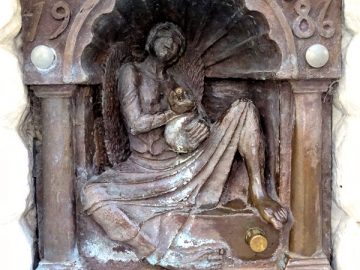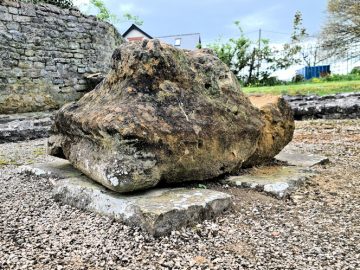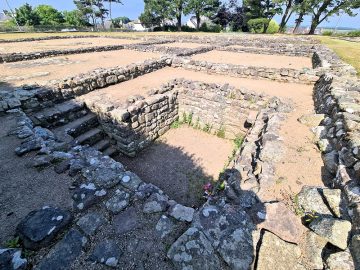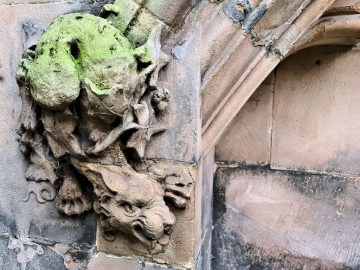Lickey Hills (south of Birmingham in the UK) is a wonderful area for relaxation, largely due to donations of land to the people of Birmingham by the Cadbury family (yes, the chocolate people) in the early 20th Century. As well as some wide open spaces to relax and play, the area also includes some beautiful woodland to explore on a lazy stroll. While walking there one day I found this interesting tree stump close to the Sixth Earl of Plymouth Monument in the village of Lickey. It seemed another nice example of how nature can provide exciting inspiration for unusual 3D scanning and model-making subjects, so I decided to try to 3D scan it.
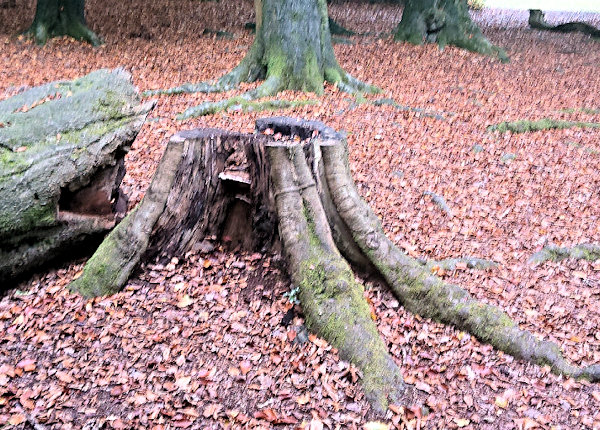
Quick summary of this 3D creation
Overview: A scan of the stump of a felled tree near the 6th Earl of Plymouth Monument in Lickey.
Location: Lickey, central England, United Kingdom [map].
Date/era: Modern, 21st Century.
Software used: Sony 3DCreator Android app, Meshmixer.
Intended use: 3D printing, either in resin or fused filament, the latter being possible without any support material.
The scan was done using the Sony 3D Creator app on an Xperia XZ2 smartphone. It didn’t pick up all of the fine details but it did quite well. In fact, the scan was surprisingly good, for a smartphone app scan, as it picked up difficult areas under the exposed roots, which went back into the trunk are were quite dark too (no light was used to help illuminate the scene). Of course, it didn’t manage to pick up details such as the bark and small leaves, but I didn’t consider that a problem for two reasons, the first being that I wasn’t trying to create a highly accurate recreation for posterity. The second reason, which is just as important, is that unless printed to a very large size those details wouldn’t show up in a 3D print anyway.
The scan was then post-processed using Meshmixer to remove extraneous areas and to remesh to a sensible file size, for speed of use in the Sketchfab viewer, as well as to allow speedier downloads. The solidify tool was used for that, with the sharp edge preserving setting allowing a sensible file size with minimal loss of the limited detail contained in the original scan. Meshmixer has a wide range of available tools that are very useful for processing 3D scans, including 3D sculpting brushes that are as good as those in many commercial sculpting packages. And, while being provided by AutoDesk, the makers of widely used professional software such as AutoCAD, it’s also free to download and use. You can see the finished model on Sketchfab below (click the play button to load the model and view it in 3D).
The example 3D print in the photo below was made using a Monoprice Mini SLA resin printer, using standard UV-curing resin. However, as there is little fine detail to worry about, it should print well in fused filament printing too. The organic nature of the shapes in the tree stump also means there aren’t any sharp overhangs, so fused-filament printing shouldn’t require much, if any, annoying support material that would need removal and filing away. So, for larger prints, or if you don’t have a resin 3D printer, fused filament printing should really be a very good option. If you want to try 3D printing it yourself, click here to go to the MyMiniFactory page to download it.
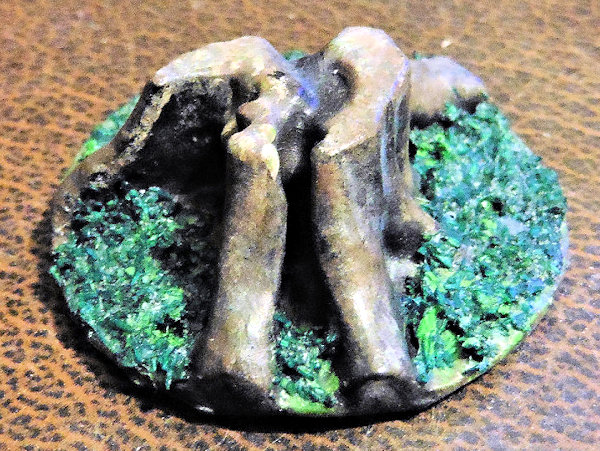
The print was then painted using Pebeo craft acrylics and a coat of anti-shine varnish. Given the uniformity of the printed resin surface, other paints (such as The Army Painter or Citadel ones) would have worked just as well too (although for fused-filament printing craft acrylics have the advantage of being thicker, and so are better at hiding layer lines). I wasn’t completely happy with the flatness of the area around the stump: despite there being no significant features on the ground around the original I felt that some texture would have helped. For that reason I added some modelling-scenery scatter grass, as sold for use on model railway scenes to add the look of rough grass, which gave a much better texture on the surrounding ground.
I did that by mixing the scatter grass with a small amount of Bostik all purpose glue and pressing it onto the model. That worked well, although it needed to be left to dry for a few hours to fully harden before painting. However, in more recent modelling I’ve also had good results simply by spreading gel-based superglue onto the print surface, then scattering the ‘grass’ onto it, later tapping to remove the excess when the glue has fully dried. And it works well for creating other textures too, such as with fine sand to emulate a rough stone or macadam path surface. I should also mention that PVA glue is widely used for scatter grass on model railways, but on smooth printed surfaces I’ve found it can peel away easily later, so it’s probably not a glue I’d use for other projects like this one.
So finally, in case you’d like to use the methods in this project for your own work, let’s recap on what was involved:
- The Sony 3DCreator Android app was used to create a basic 3D scan on a smartphone, which did a good job reproducing the complex shapes, although fine detail such as bark were obviously not in the scan.
- On a PC Meshmixer was used to tidy the 3D scan, including cutting away unwanted material, smoothing poorly scanned areas, and sharpening edges.
- Meshmixer was also used to solidify/remesh the model, to achieve a much smaller file size, using the sharp edge preserving setting so as not to lose what fine detail was available in the original scan.
- The finished 3D model was then test printed in resin and found to print to an acceptable quality.
- Due to the limited amount of detail in the final model, resin printing wasn’t strictly necessary, so it should work well with fused-filament printing too.
Please note that this model is provided without any license for commercial use. It is intended simply as a model you can have the fun of printing yourself. And of course it is intended to be a motivation for you to visit Lickey Hills yourself: click here to see the location in Google Maps.

